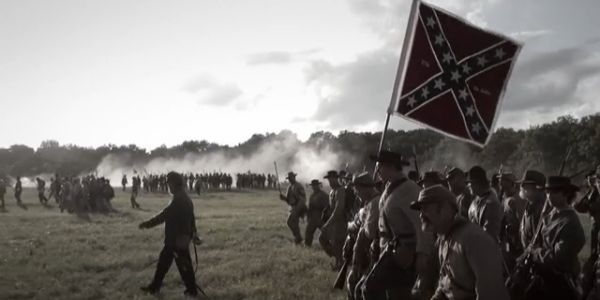The Propagandist Language Of Dinesh D’Souza: America’s Popular Far-Right Filmmaker

Data analyst living in Manchester. Writes for Film Inquiry, The…
There is no need for propaganda films anymore. The internet provides the platform for the political manipulation that had previously been designated to cinemas by ministries of propaganda. Film is still used as a political tool, not least in India and the US, but what happened to the fascinating notion of filmmakers of considerable quality using their powers for the good of an authoritarian state?
Dinesh D’Souza, celebrated far-right political commentator, author and documentary filmmaker, meets some of the above criteria. His dizzying propaganda films bleed misinformation with meme-like efficiency. The message, even four years before the election of Donald Trump, was and is scarily congruent with the new Republican Party. And the films are shown in cinemas with impressive turnouts – when they have not been prevented by a pandemic.
However, the criterion on which D’Souza always falls short – ‘artist merit’ – derails any chance of him becoming an equivalent of the Soviet or Nazi filmmakers who demonstrated that your moral core has no effect on your ability to create great art. Still, there are advantages to looking at D’Souza’s work, because he is clearly proficient in his particular style of incoherent messaging, used to influence the minds of people willing to believe there is something better than facts.
Re-enacting Distorted Histories: Pity the Martyr
Hilary’s America, D’Souza’s second attempt at influencing a US election, is a film told almost entirely through historical re-enactments. These span from the founding of the modern Democratic Party around the 1820s, to as recently as 2015. The film was released in 2016.

It begins with a prolonged fictionalisation of D’Souza’s trial and conviction for breaking campaign finance laws, and the subsequent time he spent in a confinement centre for his crimes. The re-enactment of the trial itself is disguised as news footage, though it is soon clear that what is taking place is neither reality nor a decent attempt at replicating it. The judge hisses his sentencing, emphasising each judgement viciously, while the prosecution sniggers and smirks at one another.
D’Souza wants his audience to pity him, and for that pity to develop into anger at what is objectively inexcusable behaviour within a courtroom. If it were real. Also fictitious is the idea that D’Souza spent his eight-month sentence in a prison-like institution, kept day and night, and surrounded by violent thugs.
But the overlong sequence does work well as a framing tool for the arguments he will go on to make (do these criminals remind you of the Democrats, perhaps?), as well as for his claims that Barack Obama is the one who put him there, after making the hit-job and box office-busting, 2016: Obama’s America.
However, with common-sense and evidence to the contrary, that in fact, it was only ever an over-night facility, all the curious viewer can discern from these scenes is that D’Souza is begging to be labelled a political martyr, and wants to suggest that his audience may face similar treatment for criticising a Democratic administration.
Re-enacting Distorted Histories: Fabricating Hypocrisy
On the more extreme end of this bizarre spectrum of distorted history, D’Souza is interested in associating progressive icons or Democratic leaders, historical or otherwise, with hate groups – via the convenient interpretative freedom that fictionalised re-enactments provide. The sole purpose is to undermine these figures’ significance, reassuring his audience that they should not succumb to the guilt they might feel is being forced upon them by the modern progressive movement.
Examples are the insinuation that Margaret Sanger supported the Klu Klux Klan (recreating one of her speeches, Sanger is flanked by a group of KKK members), or that Saul Alinsky was a treacherous, psychopathic socialist who is responsible for the radicalisation of such radicals as Hilary Clinton and Barack Obama.
Sometimes, however, the charge is justified, such as the re-enactment of the infamous The Birth of a Nation screening at the White House in 1915, even if Woodrow Wilson’s embrace of its glorification of the KKK is disputed.

Warping history is D’Souza’s primary strategy in each of his films because he sees no value in nuance when it comes to damning those who oppose the Republican Party. By denigrating any social reformer or Democratic politician, from any era, his audience then witnesses mostly fabricated hypocrisies within the Democratic party and the so-called liberal movement. And for this, they can feel empowered by D’Souza’s muddled but convincing reassurances.
Obama’s America: A Hitjob
Obama’s America is probably D’Souza’s most original film, mainly because of how he decodes and repackages the Obama birther conspiracy for the big screen. Famously touted by the incumbent president, this drearily racist, debunked theory says that Obama was born in Kenya, and so was ineligible for the presidency. And for the purposes of his film, D’Souza takes a trip to Kenya to confirm his beliefs (and the beliefs of 51% of Republicans).
It’s played like an episode of Who Do You Think You Are? except the person digging into your ancestry is not you, but someone who openly despises you. There are blurry shots of Barack Obama Sr.’s supposed grave in Kenya, zooming-in on his middle name, Hussain.
Then there is an interview with Obama’s “grandmother”, whose speaking fee, D’Souza says, was a goat. Bear in mind that she is never seen and that an interpreter is relaying whatever she felt comfortable saying, happy after having secured this goat. Anyway, Obama’s paternal grandmother died in 2006, and D’Souza’s racist attempt to humiliate this woman falls flat.
D’Souza is almost sociopathic in his obsession with Obama’s connection to his father. He uses Obama’s memoir, Dreams from My Father (published in 1995) – including what sounds like clips from the audiobook, read by its author – to insinuate that Obama was so reverent of his absentee father that his political ideals came from a “third-world, anti-America view”. That D’Souza uses Obama’s own voice and words, played over scenes of Kenya’s impoverished people, is a sly trick which aids his otherwise precarious argument.
Incoherence as a Virtue
By muddying the waters and overloading the viewer with scrambled information, D’Souza can crisscross multiple complex strands of history and make them seem like they are all in aid of one corrupt system. For example, by discussing and recreating the widely known history of the Democratic Party’s relationship to slavery and segregation, D’Souza argues that the Democrats were then, and are now, the sole architects of systemic racism.
In Death of a Nation, his first box office disappointment, D’Souza attempts to refute accusations that the Trump administration engages in fascistic behaviour. And like the president himself, rather than defend him, the film argues that it is in fact “the leftists” who are the real fascists.

Random footage of modern-day riots, credited to Antifa, is cut together with old footage of Mussolini’s Blackshirts committing similar acts of violence, while D’Souza states in a voiceover that Antifa and the Blackshirts are one and the same. Using the same tactics, the pro-choice movement is compared to the Holocaust in one of his lowest moments.
Each film is an incoherent attempt to further entrench the factually misguided prejudices that a chunk of the Republican base holds dear. Over and over, these little tricks and manipulations play for 90-110 minutes at a time, further goading his audience into accepting that the wildest, most improbable conspiracies are nothing less than fact.
Conclusion
D’Souza is likely correct – when reckoning with his consistently terrible critical reception – to assume that a majority of film reviewers lean to the left. But the financial success of his films means there is an audience willing to listen. When, in Trump Card, the famous torture scene from 1984 is adapted so the torturer is a Democrat and the victim is a young conservative, this surreal role-reversal will resonate strongly with many on the right because of how insidious the culture war has become.
It’s hard to do, but perhaps his films should be taken more seriously, given the time by those wanting to make sure the political discourse is not being soiled more than it already is. I repeat, it is challenging, but maybe calling his film “worthless” is the wrong way to address a difficult problem in need of a comprehensive solution.
What do you think of the director? Let us know in the comments below!
Does content like this matter to you?
Become a Member and support film journalism. Unlock access to all of Film Inquiry`s great articles. Join a community of like-minded readers who are passionate about cinema - get access to our private members Network, give back to independent filmmakers, and more.
Data analyst living in Manchester. Writes for Film Inquiry, The State Of The Arts, Vague Visages.













